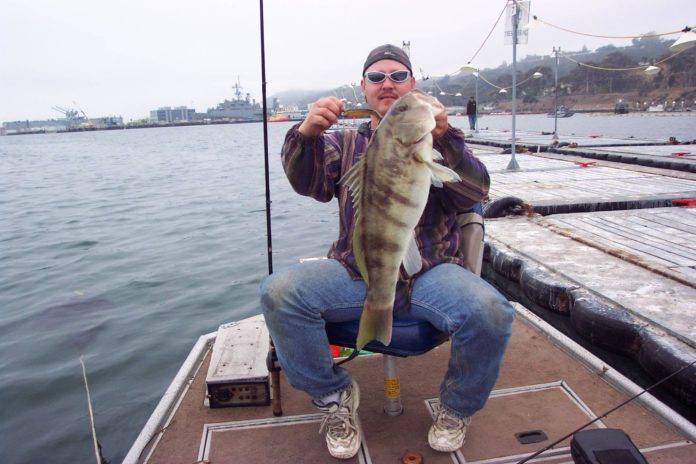Marine Resource Committee to forward recommendations for a 2-part season and range of bag limits from 1- to 5-fish.
BY MERIT MCCREA
SACRAMENTO – The Fish and Game Commission (Commission) will meet for 2 days, December 11 and 12 in Sacramento. During this meeting they will consider authorizing and the content of their Notice of Intent (NOI) to amend recreational fishing regulations for barred sand bass (BSB – Paralabrax nebulifer). This will be the first step in a 3-meeting Commission process. They will adopt a range of options for consideration. The next step is full discussion of the options, followed by the final Adoption where a selected option is forwarded to be moved into regulation. At the December meeting they will also, among many other items, consider for action the regulation changes proposed under the Bin 1 MPA regulation change petitions received. (Look for a further update on that within this issue.)
During the Marine Resource Committee meeting of November 6th and 7th this topic was discussed and several public comments heard, from diverse perspectives, including environmental groups, Representatives from the Sportfishing Association of California including Ken Franke and Merit McCrea and the Coastal Conservation Association of California’s Wayne Kotow supported constituent perspectives.
Commissioners Erik Sklar and Samantha Murray were the Commission representatives. Their final recommendation to forward to the full Commission was to approve a NOI to amend the BSB bag limit, with the following range of alternatives.
Either a full season bag-limit change or a bi-modal change with different bag limits for the summer months (June, July and August) and the rest of the year. The range of bag limits recommended was set to between 1 and 5 BSB within the 5-fish aggregate bass limit, with a sunset on any change after 3 years.
The fundamental idea is to consider a reduction in the bag limit during the summer months when BSB are most active, catches are the highest and spawning happens. After extensive discussion, the option for a fully closed (summer) season was not included the MRC’s recommended range of alternatives for Commission consideration.
Department of Fish and Game (CDFW) officials, along with the BSB working group membership supported a year-round reduction in the BSB bag limit to 4 fish with in the 5-fish bass limit, with a 3-year sunset.
Seasonally closed areas were strongly recommended against by both as unworkable. Many see temporary or partially closed areas as a stepping stone to permanent closure to all fishing. The MRC declined to include seasonally closed areas in their recommended range of alternatives for consideration.
Public comments covered a range of concerns, with a primary focus on the scientific information, what was available and its strengths and weaknesses.
This included improving the science on where most sand bass caught in SoCal waters actually come from, whether locally spawned or migratory, and how well the smallest and youngest sand bass within our waters are currently documented in scientific data.
Of particular concern to biologists was a suggestion in their data that while it appeared a substantial proportion of local sand bass are just becoming of legal size (>14 inches), there is a lower proportion of smaller fish that would be joining them in coming years.
The scientific community has been putting forward for many years that sand bass school in just a few highly localized places for spawning during summer months, which makes them susceptible to over-fishing that goes undetected.
This “hyper-stability” in catch despite a declining population size is a foundational hypothesis in marine ecology. It has been documented among other species globally and scientific efforts continue look for evidence that supports its occurrence in the wild.
However, skippers who pursue sand bass disagree that sand bass truly fit the dynamic of consistently schooling in just a few well known places and reliably found all together at relatively few specific sites during spawning.
Their local and historical knowledge indicates most of the large numbers of sand bass found some seasons out in open water follow ocean conditions and forage. They advance as far up-coast as these favorable conditions occur each year. The occasional summertime abundance of sand bass out on the flats far exceeds the number of resident fish and comes from their core population along the Baja Coast where they are much more abundant and far less seasonal.
However, scientific efforts to test that hypothesis don’t appear to have ever been attempted. Few if any major BSB tagging efforts have spanned into their core range within Mexican waters.
While there is considerable science on BSB, at the same time an official stock assessment resulting in established reference points for population size and an estimate of that has not been done.
Among many in the marine science community there is a belief that fishing during spawning is a fundamentally bad idea, and an eagerness to demonstrate the benefits of not doing so. However, for avid anglers this is tantamount to advocacy for fishing to be allowed only during times and at places when and where the probability of success is lowest. Environmental advocates who delve into fisheries policy consistently advocate curtailing fishing in favor of wild predators and other biota fishing potential impacts.
Given this triumvirate of competing perspectives on marine management, finding the winning policy is challenging. That is the Commission’s task.
Fortunately, the solution for fisheries scientists and anglers alike is a more robust understanding of where sand bass in SoCal waters come from, under what conditions and how resilient they are to fishing pressure. Anglers’ and fisheries scientists’ ultimate objective of sustainable and productive fishing is a shared one.




